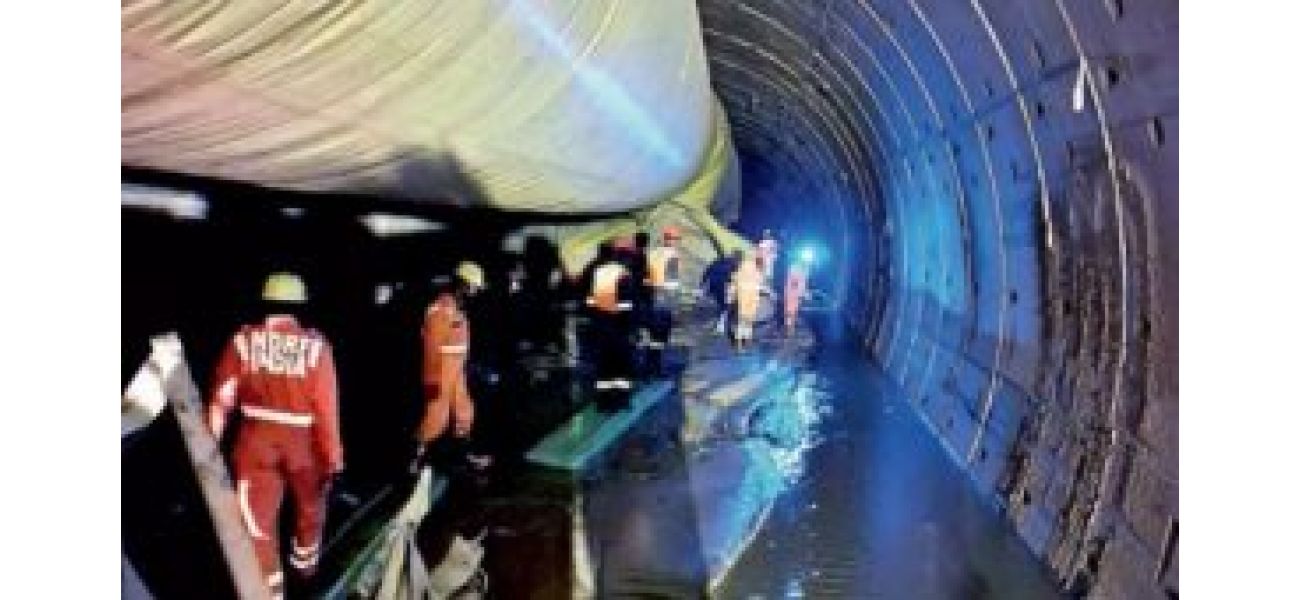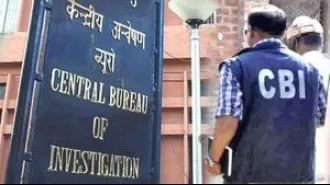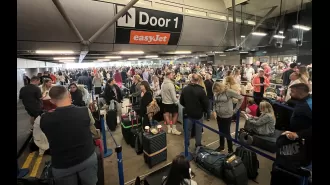New plan in place to save those affected by tunnel collapse in Telangana.
Rescue teams are adjusting their strategy to save eight people stuck in a collapsed tunnel in Telangana's Nagarkurnool district for three days, seeking help from experts.
February 25th 2025.

In the city of Hyderabad, a rescue effort has been underway for three days to save eight individuals who are trapped in an under-construction tunnel that collapsed in Nagarkurnool district, Telangana. The rescue teams are now working on a new plan to move forward in the remaining 40-50 meters of the tunnel.
The authorities are facing many challenges and have sought help from experts at the Geological Survey of India, the National Geographical Research Institute, and the National Remote Sensing Agency. These experts are assessing the situation and providing guidance on how to proceed with the rescue operations.
Multiple teams, including the National Disaster Response Force, Army, Larsen and Toubro, and other agencies, are proceeding with caution as they must consider the stability of the tunnel before undertaking any excavation work. While they continue to drain the water from the tunnel, they are eagerly waiting for the experts' recommendations for the next steps.
Various agencies, such as the Army, Navy, SDRF, National Highway Infrastructure Development Corporation, and Singareni Collieries Company Limited, have come together to create a detailed diagram of the tunnel and devise a rescue strategy to reach the trapped men.
Unfortunately, the conveyor belt used to remove debris from the tunnel is not functioning, but efforts are being made to repair it. The advanced equipment, such as endoscopic and robotic cameras, has also not been successful in locating the trapped men. In fact, the robotic camera is not working at all.
On February 22, a portion of the tunnel roof collapsed, causing the Tunnel Boring Machine (TBM) to break into two. The tail unit of the TBM was found 50 meters away from the end of the 14 km long tunnel. The head portion of the tunnel has a safe container, but it is uncertain if the trapped men were able to reach it before the roof collapsed and the water started seeping in.
The rescue teams have also been unable to access the drone after the TBM tail unit. The area is filled with sediment and debris, making it difficult for them to move forward in the last 24 hours. According to the tunnel map prepared by the rescue teams, the loco track is accessible up to 12 km, even though it is available for a length of 13.5 km.
As the rescue operation continues, it has been noted that there is no water stagnation in the tunnel until the 10.7 km point. However, there is 1.5 feet of water at the 10.95 km point and 2 to 2.5 feet of water at the 11.30 km point.
The National Disaster Response Force has also deployed a trained sniffer dog for the rescue operation, but it has not been able to help due to the slushy conditions. Additionally, a team of expert rat miners, known for their successful rescue operation in the Silkyara Bend-Barkot tunnel in Uttarakhand in 2023, has arrived, but their services have not yet been utilized. The team members have stated that the situation in Telangana is different from their previous operation, as this tunnel is filled with water and mud, making it more challenging.
Deputy Chief Minister Mallu Bhatti Vikramarka, Irrigation Minister Uttam Kumar Reddy, Roads and Buildings Minister Komatireddy Venkat Reddy, and Tourism Minister Jupally have visited the tunnel to review the rescue operations with various agencies. The Irrigation Minister has also invited Harpal Singh, a former engineer-in-chief of the Border Road Organisation, to share his expertise and knowledge for the rescue operation. Harpal Singh has reportedly stated that he has never seen such a complicated tunnel accident before.
The accident occurred when a portion of the tunnel, being dug as part of the SLBC project, collapsed near Domalapenta. A total of 50 workers were present in the left-side tunnel when the roof collapsed, trapping eight workers. While 42 workers were able to escape, the remaining eight, including two engineers and two machine operators, were trapped. These individuals hail from different states, including Jharkhand, Uttar Pradesh, Punjab, and Jammu and Kashmir.
Among the trapped men are project manager Manoj Kumar, machine engineer Srinivas, and machine operators Sunny Singh and Gurpreet Singh. The four workers from Jharkhand are Sandeep Sahu, Santosh Sahu, Anju Sahu, and Jagta Khes.
The authorities are facing many challenges and have sought help from experts at the Geological Survey of India, the National Geographical Research Institute, and the National Remote Sensing Agency. These experts are assessing the situation and providing guidance on how to proceed with the rescue operations.
Multiple teams, including the National Disaster Response Force, Army, Larsen and Toubro, and other agencies, are proceeding with caution as they must consider the stability of the tunnel before undertaking any excavation work. While they continue to drain the water from the tunnel, they are eagerly waiting for the experts' recommendations for the next steps.
Various agencies, such as the Army, Navy, SDRF, National Highway Infrastructure Development Corporation, and Singareni Collieries Company Limited, have come together to create a detailed diagram of the tunnel and devise a rescue strategy to reach the trapped men.
Unfortunately, the conveyor belt used to remove debris from the tunnel is not functioning, but efforts are being made to repair it. The advanced equipment, such as endoscopic and robotic cameras, has also not been successful in locating the trapped men. In fact, the robotic camera is not working at all.
On February 22, a portion of the tunnel roof collapsed, causing the Tunnel Boring Machine (TBM) to break into two. The tail unit of the TBM was found 50 meters away from the end of the 14 km long tunnel. The head portion of the tunnel has a safe container, but it is uncertain if the trapped men were able to reach it before the roof collapsed and the water started seeping in.
The rescue teams have also been unable to access the drone after the TBM tail unit. The area is filled with sediment and debris, making it difficult for them to move forward in the last 24 hours. According to the tunnel map prepared by the rescue teams, the loco track is accessible up to 12 km, even though it is available for a length of 13.5 km.
As the rescue operation continues, it has been noted that there is no water stagnation in the tunnel until the 10.7 km point. However, there is 1.5 feet of water at the 10.95 km point and 2 to 2.5 feet of water at the 11.30 km point.
The National Disaster Response Force has also deployed a trained sniffer dog for the rescue operation, but it has not been able to help due to the slushy conditions. Additionally, a team of expert rat miners, known for their successful rescue operation in the Silkyara Bend-Barkot tunnel in Uttarakhand in 2023, has arrived, but their services have not yet been utilized. The team members have stated that the situation in Telangana is different from their previous operation, as this tunnel is filled with water and mud, making it more challenging.
Deputy Chief Minister Mallu Bhatti Vikramarka, Irrigation Minister Uttam Kumar Reddy, Roads and Buildings Minister Komatireddy Venkat Reddy, and Tourism Minister Jupally have visited the tunnel to review the rescue operations with various agencies. The Irrigation Minister has also invited Harpal Singh, a former engineer-in-chief of the Border Road Organisation, to share his expertise and knowledge for the rescue operation. Harpal Singh has reportedly stated that he has never seen such a complicated tunnel accident before.
The accident occurred when a portion of the tunnel, being dug as part of the SLBC project, collapsed near Domalapenta. A total of 50 workers were present in the left-side tunnel when the roof collapsed, trapping eight workers. While 42 workers were able to escape, the remaining eight, including two engineers and two machine operators, were trapped. These individuals hail from different states, including Jharkhand, Uttar Pradesh, Punjab, and Jammu and Kashmir.
Among the trapped men are project manager Manoj Kumar, machine engineer Srinivas, and machine operators Sunny Singh and Gurpreet Singh. The four workers from Jharkhand are Sandeep Sahu, Santosh Sahu, Anju Sahu, and Jagta Khes.
[This article has been trending online recently and has been generated with AI. Your feed is customized.]
[Generative AI is experimental.]
0
0
Submit Comment





